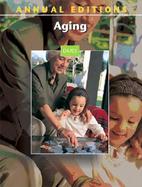Aging 04/05
- List Price: $20.93
- Binding: Paperback
- Edition: 16
- Publisher: McGraw-Hill College
- Publish date: 08/01/2003
Description:
UNIT 1. The Phenomenon of Aging1. Elderly Americans, Christine L. Himes, Population Bulletin, December 2001The author points out the ever-growing number and percentage of the American population comprising persons 65 years of age and older. Further, she observes that those over 65 are living longer than previous generations. Currently those 85 and older are the fastest growing segment of the elderly population.2. Great Expectations, Harvard Health Letter, December 1999This article points out the dramatic increase in life expectancy in the U.S. population between 1900 and 1996. From 1900 to 1950 the biggest gains resulted from curbing the communicable diseases of young people. From 1950 to 1996 the increase in life expectancy is believed to be a result of success against the chronic diseases of middle- and older-aged persons.3. A Study for the Ages, Nancy Shute, U.S. News & World Report, June 9, 1997The Baltimore Longitudinal Study of Aging (BLSA) has followed more than 2,000 volunteers between the ages of 20 and 90 in an attempt to delineate how healthy people grow older. The BLSA found that function losses that were once thought to be age-related, such as decreased mobility or memory lapses, can be slowed or stopped. Furthermore, many supposed indignities of aging turn out to be purely misconceptions.4. The Centenarians Are Coming!!, Cynthia G. Wagner, The Futurist, May 1999Cynthia Wagner examines the lives of people who live to 100 and beyond in an attempt to find the critical factors that allow them to outlive so many of their cohorts.5. Will You Live to Be 100?, Thomas Perls and Margery Hutter Silver, AARP Modern Maturity, November/December 1999After completing a study of 150 centenarians, Harvard Medical School researchers Thomas Perls and Margaret Hutter Silver developed a quiz to help you calculate your estimated life expectancy.6. The Centenarian Boom: Providing for Retirement in a Long-Lived America, Henry J. Aaron, Brookings Review, Spring 2000Some economists look at the ever-increasing numbers of people living to 65 and beyond as a major financial crisis for nations as they attempt to keep government pension programs running. Henry Aaron, on the other hand, believes that governments with sound fiscal policies will balance their own budgets so that voluntary savings and pension savings in the private and public sector will be available for investment and growth at home and abroad.UNIT 2. The Quality of Later Life7. Women's Sexuality as They Age: The More Things Change, the More They Stay the Same, Patricia Barthalow Koch and Phyllis Kernoff Mansfield, SIECUS Report, December 2001/January 2002The authors examine women's sexuality over the life cycle in an attempt to determine whether there are any changes in female sexuality as a result of aging or menstrual status.8. Fighting Back, With Sweat, Jerry Adler and Joan Raymond, Newsweek, Fall/Winter 2001The authors point out the numerous health advantages that accrue to those who are physically active and exercise on a regular basis.9. All in Your Head, Richard Restak, AARP Modern Maturity, January/February 2002The author compares the way the brains of younger and older persons process and integrate new information. He challenges many long-held beliefs about how the brains of older persons lose functions.10. Late Life Widowhood, Selfishness and New Partnership Choices: A Gendered Perspective, Kate Davidson, Aging and Society, Volume 21, 2001The reactions of widows versus widowers are compared with regard to how they responded following the death of their marital partner and whether they would or would not be likely to marry again.11. Men and Women Aging Differently, Barbara M. Barer, International Journal of Aging and Human Development, Volume 38, Number 1, 1994Gender differences in health, socioeconomic status, and social resources during later life are examined by Barbara Barer. Case studies illustrate how the timing of life-course events is different in men
Expand description
Product notice
Returnable at the third party seller's discretion and may come without consumable supplements like access codes, CD's, or workbooks.
| Seller | Condition | Comments | Price |
|
Wonder Book - Member ABAA/ILAB
|
Very Good |
$5.66
|
|
Ergodebooks
|
Good |
$6.70
|
|
Bonita
|
Good
|
$38.31
|

Please Wait

